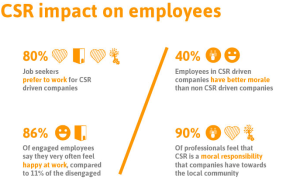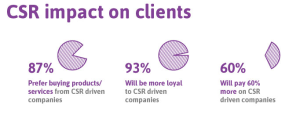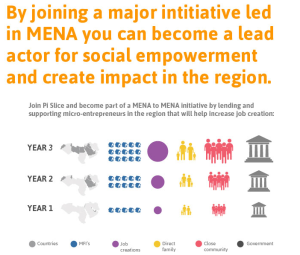
 As the World Economic Forum (WEF) wrapped up its annual summit in Davos last week, we continue to learn new and innovative ideas related to sustainable development. In this article, we focus on Corporate Social Responsibility (CSR) as a key channel for setting-up the path for sustainable development on multiple levels. Before we delve deeper into the impact of sustainable development, we want to take a step back and ask a simple question, what does CSR mean? The European Commission defines CSR as a concept and a practice where “[c]ompanies integrate social and environmental concerns in their business operations and in their interaction with their stakeholders on a voluntary basis. […] Being socially responsible means not only fulfilling legal expectations, but also going beyond compliance and investing ‘more’ into human capital, the environment and the relations with stakeholders.” With this definition in mind, we will divide this article into the following sections: 1) CSR Objectives; 2) CSR Benefits; 3) CSR Impact; 4) CSR Challenges; and 5) Overcoming Challenges: The Pi Slice Model.
As the World Economic Forum (WEF) wrapped up its annual summit in Davos last week, we continue to learn new and innovative ideas related to sustainable development. In this article, we focus on Corporate Social Responsibility (CSR) as a key channel for setting-up the path for sustainable development on multiple levels. Before we delve deeper into the impact of sustainable development, we want to take a step back and ask a simple question, what does CSR mean? The European Commission defines CSR as a concept and a practice where “[c]ompanies integrate social and environmental concerns in their business operations and in their interaction with their stakeholders on a voluntary basis. […] Being socially responsible means not only fulfilling legal expectations, but also going beyond compliance and investing ‘more’ into human capital, the environment and the relations with stakeholders.” With this definition in mind, we will divide this article into the following sections: 1) CSR Objectives; 2) CSR Benefits; 3) CSR Impact; 4) CSR Challenges; and 5) Overcoming Challenges: The Pi Slice Model.
1. CSR Objectives

Corporate Citizenship: Giving back to the community but without expectation of corporate gain, such as revenue increase, and integrating corporations into communities by providing funding, skills and time. The indirect gains would promote the corporate’s brand and employee engagement.
Shared Value: Creating a community of responsible and mutually dependent stakeholders such as corporations, institutions and communities by creating shared value that would complement corporations and the surrounding community.
Risk Management: Complying with ethical rules and policies in order to eliminate operational risks or damaged relationships.
Branding & Visibility: Widening recognition of corporations through corporate citizenship, sponsorships and shared value.
2. CSR Benefits

Employee Engagement: Improved employee performance that results in developing human capital through innovation and creative thinking. Our recent study shows that 80% of job seekers prefer to work for CSR driven companies and that 40% of employees in CSR driven companies have stronger morale and deliver better performances.
Responsible Citizenship: Building a community of aware and committed citizens to promote public good and social causes.
Increased Sales & Customer Loyalty: Another conducted study shows that 87% of clients prefers buying products/services from CSR driven companies. In addition, companies with engaging CSR activities have increased their pool of loyal clients in comparison to companies with lacking CSR initiatives.

Enhanced Branding & Visibility: A company that is socially responsible can benefit from its increased credibility and accountability and its reputable status within the business community, which in turn, increases a company’s ability to attract more funds and trading partners.
3. CSR Impact
Job Creation: Strengthening the development and growth of SMEs create more jobs.
Education: Improving educational systems to be responsive to the market needs and demands, including implementation of robust soft skills training programs.
Capital: Increasing access to capital especially through transparent online platforms that monitor and evaluate results of capital investment to prospective and potentially excluded SMEs.
Economic Development: Encouraging corporations to be more responsible towards the community by investing in youth development and women empowerment through education, job creation and entrepreneurship.
4. CSR Challenges
Adequate Guidance: Misalignment and lack of innovative connection between social missions and CSR strategies.
Transparency: Lack of publicaly accessible and traceable CSR initiatives, such as online campaigns, that show the effectiveness and long lasting impacts on corporations and communities.
Cost Effectiveness: Investment in CSR goes beyond charitable acts and offers ROI through improved employee performance, social engagement, job creation and economic growth.
Accountability: Need to integrate monitoring and evaluation systems to explain who is responsible for the initiatives, how they are being implemented, type and frequency of follow-up activities and delivery of results.
Measuring Impact: Concentrated attention on short-term results and lack of awareness and understanding of long-term outcomes of CSR initiatives. This resulted in the underdevelopment of proper indicators that measure outcomes, such as improved employee performance, increased understanding of the long-term impact of their investment in CSR initiatives, increased brand loyalty among clients; and strengthening the socio-economic development of communities. These examples illustrate the importance of implementing timelines for impact measurement.
Geographic Outreach: Neglecting excluded target audience/beneficiaries who are geographically located outside of countries where corporations operate.
5. Overcoming Challenges: The Pi Slice Model
 Pi Slice is a social web-based platform – developed in partnership with MicroWorld- that offers corporations the opportunity to participate in the development of microfinance with an innovative and sustainable CSR initiative. We promote social awareness and change through microlending. Our online platform motivated individuals and corporations to help Micro Finance Institutions (MFIs) in the Middle East and North Africa (MENA) region to build a sustainable future for micro-entrepreneurs and a favorable ecosystem for macro development. Additionally, Pi Slice joins forces with all types of corporations in the private sector to respond to the growing need for alleviating unemployment in the MENA countries by strengthening Small Medium Enterprises (SMEs) to promote job creation through lending to of micro-entrepreneurs, ongoing community engagement and mobilization.
Pi Slice is a social web-based platform – developed in partnership with MicroWorld- that offers corporations the opportunity to participate in the development of microfinance with an innovative and sustainable CSR initiative. We promote social awareness and change through microlending. Our online platform motivated individuals and corporations to help Micro Finance Institutions (MFIs) in the Middle East and North Africa (MENA) region to build a sustainable future for micro-entrepreneurs and a favorable ecosystem for macro development. Additionally, Pi Slice joins forces with all types of corporations in the private sector to respond to the growing need for alleviating unemployment in the MENA countries by strengthening Small Medium Enterprises (SMEs) to promote job creation through lending to of micro-entrepreneurs, ongoing community engagement and mobilization.
How Pi Slice’s model can overcome the above CSR challenges:
Adequate Guidance: We designed a new, innovative and transparent model of on online microlending platform that directly connects corporates and employees to support microfinance projects that are aligned with their social mission.
Transparency: We established an online microlending platform that allows companies and individuals to regularly monitor and evaluate the impact of their investment in selected microfinance projects.
Cost Effectiveness: We inspire private sector investment in microfinance to transforming unemployment into prosperity and to promoting youth engagement, women empowerment and economic growth.
Accountability: We provide an online link to CSR initiatives that also serves as a monitoring and evaluation tool to track how CSR initiatives are being implemented and managed.
Measuring Impact: We designed an online platform that allows corporations and individuals to measure the outcome of their investment in terms of job creation, social impact on families and communities, as well as size and level of community engagement, which ultimately inspires educational systems and governments to advocate for innovative initiatives and practices.
Geographic Outreach: We target the MENA region with a specific focus on the three million eligible for microfinance funding but lack access to capital.
Pi Slice Infograhics on “Why CSR matters in MENA”: http://visual.ly/why-csr-matters-mena
Sources
http://blogs.hbr.org/2012/01/why-csrs-future-matters-to-you/
http://eur-lex.europa.eu/LexUriServ/site/en/com/2001/com2001_0366en01.pdf


